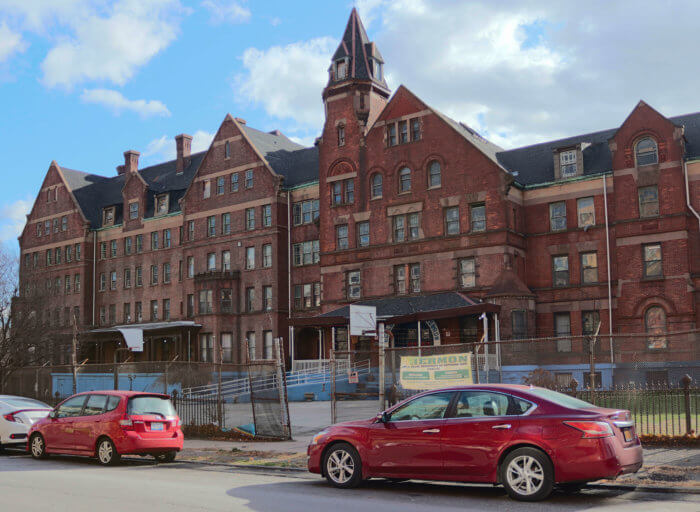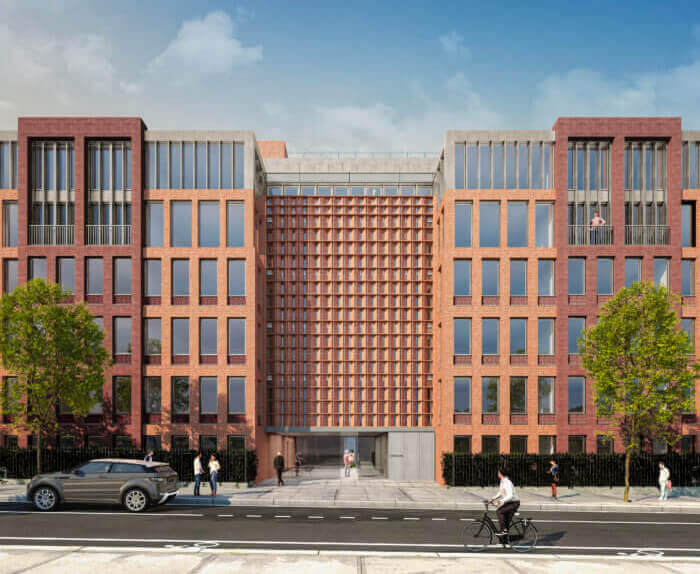Community members voiced their overwhelming opposition to a proposed seven-story apartment building in the Crown Heights historic district on Thursday, saying the project is out of character for the area’s landmarked section, and would accelerate gentrification in the working-class enclave.
“They need to go back to the drawing board and start again,” said Phara Souffrant Forrest, the Democratic nominee for the area’s 57th Assembly District.
The Land Use Committee of the area’s Community Board 8 voted 14-to-2 to withhold support for developer Hope Street Capital’s plan, which needs approval from the city Landmarks Preservation Commission to build in the Crown Heights North landmarked district.
The developers are seeking a Certificate of Appropriateness to build the proposed 180-unit building on Sterling Place between New York and Brooklyn Avenues, in the back lot of the former Methodist Home for the Aged — a stately 19th-century era building that has dilapidated over the past several decades.
The proposed project is backed by the regional leadership of the Seventh Day Adventist church, who say the revenue is needed to restore the Home for the Aged, which houses the Hebron Seventh Day Adventist School, and is currently crumbling and uninhabitable.
Congregants however have charged that most longtime church members do not support the project, and that those who voted in favor during a poll taken years ago did not fully understand what they were voting for.
“The majority of the church members do not speak English,” said congregant Ritha Pierre. “The majority of them did not really understand what was going on.”
Other congregants say the regional conference is going against the wishes of rank and file church members, and have ignored their advice on applying for grants from the city to care for the landmarked structure.
“The majority of the congregants don’t approve of this project, because of the way the project is going,” Barbara Germain, a member of the church for over 30 years, told Brooklyn Paper. “The conference is taking the lead on everything where it’s not supposed to be. It’s supposed to be us, and for them to help us in a legal aspect, but it’s supposed to be us because it’s our asset, we have the final word.”
Other longtime residents worry that the building would be out of place in the neighborhood of brownstones and pre-war apartment buildings, with one Sterling Place resident decrying that the new building would block their view of the historic home.
“You are deciding to create a tragedy!” said Gerianne Scott, who lives in the same Sterling Place home since her grandparents purchased 70 years ago. “We are here 60, 70 years because of the beauty and the air, and the seeing the sky, and the neighborhood. You cannot do this!”

Dr. Daniel Honore, the President of the Northeast Chapter of the Seventh Day Adventist Church, argued that the proposed building would pay homage to the Crown Heights historic district surroundings — and that it was the only feasible method for raising the revenue needed to repair the crumbling structure.
“We know no other way,” he said.
Another contentious sticking point for some opponents came with a heated debate of the affordable housing units the proposed new structure promises to bring.
While the developer has committed to ensuring that 30 percent of the units would be “below market rate” housing under the city’s Affordable Housing New York program, some housing activists pointed out that the program allows the developer to charge rents at 130 percent of the neighborhoods Area Median Income, while still being classified as “affordable.”
“It’s not part of the LPC but it’s very important to see that we get affordability levels that meet the communities’ needs,” said Community Board 8 Land Use Committee member Gib Veconi. “A Community Board is expecting to see affordability at the median income that meets the neighborhood’s needs.”
Hope Street, which could opt for targets between 40 and 130 percent of the AMI, did not indicate which option of affordability under the city program they would pursue.
Veconi warned community members that a project that goes before the LPC is likely to be built in some form, and that they will likely have better luck trying to influence the development to better benefit the community than trying to defeat it outright.
LPC commissioners have the final say on landmarking issues, which do not go before the city council or mayor.
“The opportunity to defeat the project on the battlefield is not a particularly strong one,” Veconi said. “The community has a better opportunity to try to get commitments from the developers to address some of these issues that were raised about context and about affordability than trying to browbeat the project into nonexistence.”
The project will go before the full community board for their advisory vote next week before the LPC votes later this year.





















